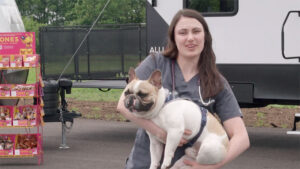rving with pets - paws on board
Protect your Pet From Dehydration - and also Meet Jones Natural Chews!
Welcome to “RVing Today’s” “Paws on Board.” I’m Dr. Fitz, and this is Ace.
 Today we’re gonna be discussing dehydration. We discussed a similar topic, heatstroke, in season one of “Paws on Board,” so make sure you check out that episode as well. When you’re on the road, your pet could easily become dehydrated, and today we’ll look at several different ways that this can happen. One, if you’re out and about, taking a hike, walking around town, or even during a long travel day, your pet could become dehydrated. This can be any situation where they’re very active, it’s very warm, or they have long periods without access to water. Two, if your pet becomes sick, they can become dehydrated. For example, repeated vomiting or diarrhea can quickly deplete body fluid, especially in very young or very old pets or pets with chronic conditions, which leads us to number three. Pets with chronic conditions such as kidney disease can become dehydrated more quickly than a healthy pet. Keep this in mind if you travel with a chronically ill pet. So now you know a bit about how dehydration can happen. What does it look like? A dehydrated pet may be more lethargic, meaning they’re more tired and not as interested in activity. They may not be interested in food, and they might vomit. Their saliva can actually become more thick and stringy versus its normal watery consistency, and their gums will be tacky and not moist to the touch. A common misconception is that a dog’s nose is a good indicator of if they are sick or not. Whether a dog’s nose is wet or dry is not directly related to their health, so try not to use this to monitor your pet’s hydration.
Today we’re gonna be discussing dehydration. We discussed a similar topic, heatstroke, in season one of “Paws on Board,” so make sure you check out that episode as well. When you’re on the road, your pet could easily become dehydrated, and today we’ll look at several different ways that this can happen. One, if you’re out and about, taking a hike, walking around town, or even during a long travel day, your pet could become dehydrated. This can be any situation where they’re very active, it’s very warm, or they have long periods without access to water. Two, if your pet becomes sick, they can become dehydrated. For example, repeated vomiting or diarrhea can quickly deplete body fluid, especially in very young or very old pets or pets with chronic conditions, which leads us to number three. Pets with chronic conditions such as kidney disease can become dehydrated more quickly than a healthy pet. Keep this in mind if you travel with a chronically ill pet. So now you know a bit about how dehydration can happen. What does it look like? A dehydrated pet may be more lethargic, meaning they’re more tired and not as interested in activity. They may not be interested in food, and they might vomit. Their saliva can actually become more thick and stringy versus its normal watery consistency, and their gums will be tacky and not moist to the touch. A common misconception is that a dog’s nose is a good indicator of if they are sick or not. Whether a dog’s nose is wet or dry is not directly related to their health, so try not to use this to monitor your pet’s hydration.
A quick test that you can do is to check your pet’s skin turgor. In a healthy dog, if you pinch the skin and pull up, the skin should bounce back to normal position very quickly. In a severely dehydrated pet, the skin may take longer to bounce back and will hold that pinched position for longer. So what should you do if you suspect that your pet is dehydrated?
If your pet is showing signs of severe dehydration such as poor skin turgor, vomiting, and is very lethargic, they should be seen by a veterinarian right away. Severe dehydration can cause problems to internal organs, and your pet should be rehydrated under the supervision of a veterinarian. Like with heatstroke, you should get your pet out of the sun and into a cool location and allow them to relax. If they’re mildly dehydrated, offer them small amounts of water frequently. Drinking full bowls of water very quickly can cause its own problems, and if you correct dehydration too quickly, this can lead to fluid imbalances in the body. Again, if your pet is not improving, they should be seen by a veterinarian. There, they can receive fluid therapy and any other supportive care that they may need. So how do you avoid this situation in the first place? If you’re traveling in your RV for most of the day, make sure to give your pet breaks frequently so that they can use the bathroom and drink some water.
If you’re hiking or walking around town, make sure to have water and portable bowl with you to keep your pet hydrated. Keep in mind that when they’re active, your pet will need more water to drink than they would when relaxing at home. Also take the heat into account. Heatstroke and dehydration are closely associated. If it’s warm outside, you should give your pet frequent water breaks in the shade to cool off. Dehydration can become serious very quickly, so having water on board can keep your paws on board happy and hydrated. For more information about traveling safely with your pets, visit RVingToday.tv.
Dr. Fitz: All right, we have a good friend here today for “Paws on Board.” This is Britney from Jones Natural Chews. Welcome to the show.
Britney McKay: Thanks for having me. Dr. Fitz: We’re here to talk about Jones Natural Chews. Can you tell us a little bit about the company and what you guys are all about? Britney: Yeah, the company was founded in 1991 by the Jones family. They owned a meat locker and butcher shop, and so dog chews were kind of like a natural product extension. 1991 is when they, like, fully committed to the dog chews line, and so they’ve been making natural bones, chews, and treats ever since. Dr. Fitz: Okay, what makes the Jones Natural Chews different from normal, like, dog treats? What are you guys all about there? Britney: So, everything is natural. Like I said, no artificial ingredients included, and that’s great for a dog’s diet.
Dr. Fitz: Exactly. Britney: And everything is sourced out in the United States, and all the manufacturing is done in our own plants, so quality is really important for our furry family members. So we keep a really,
like, tight hold on that.
Dr. Fitz: Perfect. That’s awesome. And you guys have all sorts of products. You have bones to, like, pig ears, and then you also have, like, bags of treats?
Yes, anything fun to treat or reward your dog with, we cover it. So you have those bones, and then you have, like, turkey treats, and then smaller, like, training-treat type thing?
Britney: Yeah, everything is meat-based, and meat’s always the first ingredient because dogs need lots of protein in their diets. So, we have the bagged treats, so, jerky sticks. We have links, a pretty wide variety, and then we have patties as well, and then chews, so, yeah, there’s a lot of great functional ingredients, and one of our first was actually, like, a rolled pigskin. It’s great for dogs too. Yeah, good for, you know, skin and coat health.
So you have a nice variety for dogs that have different preferences and people that wanna maybe break some of ’em up and give small training treats, so you’ve got some good options.
Well, thanks, Britney.

